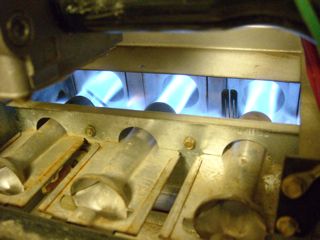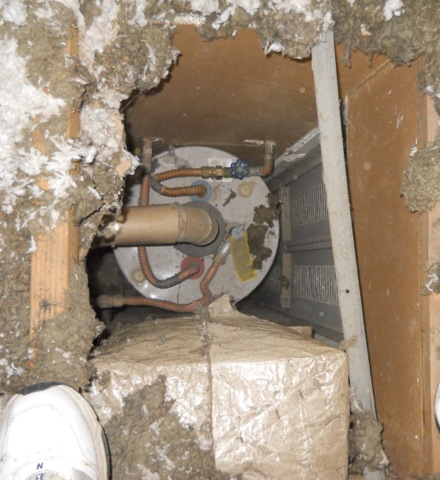Fixing an Old House? Follow Einstein’s Advice

I get a lot of questions from people asking how they should go about fixing their homes. Sometimes it’s specific (What’s the best way to insulate my kneewalls?), and sometimes it’s a hands up in the air, With all these problems, where do I start? I’ll focus on the latter today and let Albert Einstein provide the guidance you need.
Einstein was a smart fellow. His theory of general relativity is so difficult that in the early years, scientists speculated that only three people in the whole world understood it. He also had a knack for cutting to the heart of a matter, and many of the things he said have a much broader applicability than just the world of physics. For example, what he said about problem solving should be your guiding principle if you intend to address the energy effeciency and performance of an old house.
“If I had an hour to solve a problem I’d spend 55 minutes thinking about the problem and 5 minutes thinking about solutions.”
Create your plan
An older homes is a complex system of building enclosure and HVAC problems. It can be unsafe, smelly, uncomfortable, rotting, ineffecient, and downright scary. For purposes of this article, I’m going to assume that the house is livable. Also, newer homes may have many of the same problems as older ones, but Einstein’s advice applies no matter the age of your home.
Step 1 is to figure out what exactly you’re dealing with. If you’re a homeowner looking at this as a DIY project, I suggest you bring in a professional to help with the analysis, especially if you  have combustion appliances in the home. Hire a pro who can do combustion safety testing so that you’ll know how likely you are to get carbon monoxide in your home by backdrafting a water heater or furnace. They’ll also be able to spot other potential hazards, such as asbestos.
have combustion appliances in the home. Hire a pro who can do combustion safety testing so that you’ll know how likely you are to get carbon monoxide in your home by backdrafting a water heater or furnace. They’ll also be able to spot other potential hazards, such as asbestos.
A big part of your plan needs to include sequencing. It’s important to do things in the right order, not only because of cost but also safety. For example, if you need more insulation in your attic, you don’t do that until you address the air sealing. It’s more expensive and disruptive to have to air-seal a ceiling after you’ve installed new insulation.
But you don’t want to do the air-sealing until you know what you’re dealing with in terms of combustion safety. If you have a natural draft water heater or furnace inside your home, making the home more air-tight may put it over the edge and cause backdrafting that puts carbon monoxide into your home. Get a pro to assess the combustion appliances and do worst case depressurization tests for your home.
Ask a lot of questions
Here are some important questions to ask in the planning and assessment phase:
Why do you want to do this? Maybe it would be better to move, or not to buy the house if you’re still looking.
What’s your budget? It’s better to get clear on this early in the project…and expect it to be higher than you imagine.
Will you be getting it all done at once, or will you need to stretch it out over a few years? Doing it all at once is better but may not fit in your budget.
If you need to finance the project, what options are available to you? An Energy Improvement Mortgage can be a great option.
What incentives can you draw on to help cover your costs? Are there utility rebates or government tax incentives in your area?
Are there any historical preservation restrictions or objectives? If it’s a really old house or in a historic district, you may be limited in what you can do.
How far will you go with the improvements? Just make it comfortable and safe? Deep energy retrofit? Net zero energy consumption?
Who will manage the work? On larger projects, hiring a pro will probably be worth the extra cost.
 What health and safety problems need to be addressed first? A natural draft furnace in that hall closet is a high priority.
What health and safety problems need to be addressed first? A natural draft furnace in that hall closet is a high priority.
Will you be moving the building enclosure? Encapsulating a crawl space or attic can lead to big improvements but will not be cheap.
Will you be replacing HVAC equipment? If your furnace or air conditioner is more than a decade old, it’s at least time to start planning for it.
Will you need to add mechanical ventilation? Air-tight homes need fresh air.
Does switching fuels make sense for you? In some cases, you might want to get rid of your natural gas, propane, or oil-burning heating equipment and go with electric heat pumps. In other cases, you might want to switch from electricity to gas, propane, or oil. You’ve got to look at the numbers to make this determination.
Should you add photovoltaics to generate solar electricity? If you’re planning to go net-zero, the answer is probably yes.
What materials do you want to use? Some people want to use natural materials as much as possible, or materials with low or no VOCs.
What’s the proper sequence for doing the work? As mentioned above, getting this right not only saves money and time, but also can affect health and safety.
Keep in mind that this list of questions is not complete. Every house has unique characteristics and will require a solution tailored to its needs and your goals for the project. Working with a pro can help you come up with the one appropriate for you and your home.
Following the critical path
Seth Godin’s article today is titled Understanding Critical Path and fits right in with this discussion. As he writes, “Critical path analysis works backward, looking at the calendar and success and at each step from the end to the start, determining what you’ll be waiting on.” Again, it’s all about planning. Knowing what you have and where you want to go with it. Thinking through all the steps and giving your project the greatest possibility for success.
Back to Einstein’s quote – Remember, he said he’d spend most of his time thinking about the problem before trying to tackle the solution. Once you have a thorough understanding of what you’re dealing with, it’s a lot easier to know what to do.
Allison A. Bailes III, PhD is a speaker, writer, building science consultant, and the founder of Energy Vanguard in Decatur, Georgia. He has a doctorate in physics and writes the Energy Vanguard Blog. He also has written a book on building science. You can follow him on Twitter at @EnergyVanguard.
Related Articles
How I Learned to Count by Building a Green Home
How to Choose a Company to Do a Home Energy Audit
Comments are closed.
This Post Has 11 Comments
Comments are closed.

Glad you liked the Einstein
Glad you liked the Einstein quote! With a bit more time spent up front, customer problems can be both understood (I can’t fix that cold spot if you don’t tell me you have it) and good solutions can be devised.
I keep finding the answer to better Home Performance solutions is more time, not less. I used to do a quote in an hour. (Sure, I can quote you for insulation.) That was before I understood Building Science. Now I need to think more.
Good point on hiring someone to manage the process. I have a bit of trouble wrapping my head around everything that has to be done on a house, and my BS understanding is above average. Most homeowners don’t want to become experts in this, and as a profession we can help them.
IT ALL STARTS WITH AN ENERGY
IT ALL STARTS WITH AN ENERGY ASSESSMENT!
As Nate suggests, to do this
As Nate suggests, to do this right isn’t something that can be done well in a rush.
In fact houses are pretty sturdy and when you do this WRONG the problems don’t start to manifest for years.
I’m starting to see people who have had rushed work designed and implemented poorly. Their homes are beginning to show mold, have drywall tape pop, etc. What they all have in common is design was not COMPREHENSIVE. Comprehensive takes time, and I believe it takes collaborative effort. (I can’t do it alone)
Would you trust an architect to design your house in an hour? Or would you want to engage in an iterative design PROCESS?
Let’s make this into smaller steps. Start by understanding problems, opportunity, and the homeowners situation. Do no harm should apply to finances too.
My job is to:
1 Help people understand their problems.
2 Develop a budget that will NOT take food off their childrens plates at the end of the month (this part requires delicacy, and is a big part of the value auditors should bring).
3 Understand OPPORTUNITY (Improvements for some houses cost more than on others, and the energy savings ability to carry part or all of those improvements varies too)
4 Help homeowners understand if the AUDIT process is a good fit for them.
There are those in this industry with self-interest in selling that makes the sale “faster”. That is exactly the WRONG way to go, as Nate suggests we need to SLOW DOWN and be more thoughtful.
These great suggestions and
These great suggestions and many others are just published in the second edition of No-Regrets Remodeling from the editors of Home Energy Magazine. Here is a quote from page 5, “Time spent planning will pay you back handsomely. Consider your options, make all you decisions before you start….”
“Insanity: doing
“Insanity: doing the same thing over and over again and expecting different results.
Albert Einstein”
This means if you have to do a 4 hr Science Project, Full Monte, Proctological, Circus Act Audit complete with Blower Doors, Duct Blasters, X-Ray Vision Glasses, etc, etc, on every home in a 10 year old subdivision of 30,000 houses you are insane.
Our view is that a 4 hr or
Our view is that a 4 hr or more science project is not necessary in many cases, AND that gathering a bunch of data to input to a simulation to tell you what you already knew needed to be done is crazy! A simple and sophisticated checklist would work fine for most single family buildings.
John, seems you disagree with
John, seems you disagree with the blog premise?
This seems an all too common perspective borne out of the free weatherization programs; “you know what they need.” which is close cousin to; “eh, 100,000btu/4 ton should do it.”
Unfortunately you not only have infinitely unique problems, you have infinitely unique budgets and priorities, and savings opportunities that must all come together in optimized design.
If someone wants a suit tailored to fit their taste AND budget, how do you arrive there by spending 5 minutes to understand their problems?
So, where exactly do you want to cut corners in the design process? What exactly are you saving by doing this?
@Ted Kidd
@Ted Kidd
Ted I partially agree with the premise, I think it is quite overblown in application.
In California and elsewhere the stimulation money made you measure a bunch of things and put it into a simulation program to produce a prioritized list that was both incorrect, excessive, and took long to gather the information.
So: 1) measurements are good – blower door in most cases, duct leakage, and combustion safety (as the originator of that we see overcomplication as well).
2) if there is no insulation in the walls or ceiling or little in the ceiling — insulate.
3) If there are disconnected ducts, then reconnect them and test the duct leakage after that.
4) Don’t rip out a furnace, boiler, air conditioner, or heat pump just because it is old and the rule of thumb in the computer program says it is inefficient.
5) Don’t replace electric resistance baseboard heaters with a ducted heat pump. Put in real thermostats on them.
6) If there is enough money to redo the duct system then put in new short runs (not to the edge of the house) and insulate the hell out of them if they are outside the conditioned space.
7) If the heating and cooling bills are very low and the customer is comfortable, do none of the above.
— on and on — twitter @proctoreng
Essentially there can be for a certain climate a checklist that runs from the most important to the least important. If items 1 through 3 are already done, then the options start, in priority order at number 4. The customer will perhaps want number 6 instead of number 4 — that is the reality of the market.
In short — 5 minutes is to
In short — 5 minutes is to short, 4 hours is too long. Weatherization programs we see overdo the analysis and waste a lot of money then do too little of the right things
Yes, I like that.
Yes, I like that.
Yoder ermine opportunity first. Get process sequence IN ORDER. You might enjoy this little calculator and key: http://bit.ly/Homescale
Then, if opportunity exists, learn customer priorities (pain), help them develop a budget (money), and agree upon decision making process (time to present solutions developed).
Thank you.
Thank you.